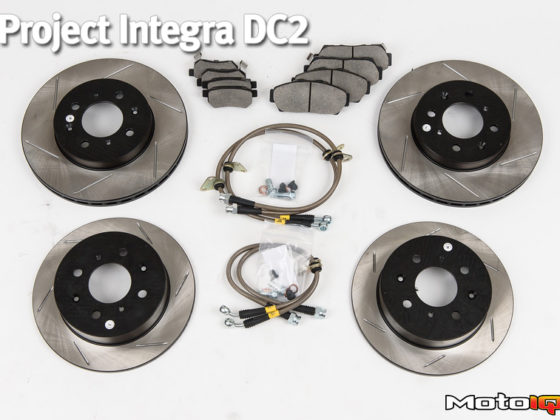
Evaluating the ACT Heavy Duty Clutch and XACT Prolite Flywheel for the Honda S2000
Vince, our FNG, drives a Honda S2000 that serves as his daily driver. The S2K takes him to work and school day in and day out. However, the Honda also serves as a track day vehicle seeing duty at Willow Springs, Buttonwillow and Cal Speedway. After serving reliably for 80,000 miles the clutch suddenly went out on Vince on his way to work.
We now had a good opportunity to evaluate something. A performance clutch for a daily driver is a tall order. Not only does it have to work smoothly without jerking and being a pain in the neck with a heavy stiff pedal, but it also has to hold more power and stand up to track abuse.
We have found that there are more features and more engineering going into a good heavy duty street clutch than there is in full race clutches, which really only have to hold power and be light. If you are interested in what makes a good dual purpose clutch check this out as we install it and a lightweight flywheel in our FNG's daily.
 After looking at various clutch and flywheel combinations, we decided to use Advanced Clutch Technology or ACT's HD Clutch and XACT flywheel. The ACT HD clutch seemed to have a good combination of features that would suit Vince's usage.
After looking at various clutch and flywheel combinations, we decided to use Advanced Clutch Technology or ACT's HD Clutch and XACT flywheel. The ACT HD clutch seemed to have a good combination of features that would suit Vince's usage.The ACT clutch's HD pressure plate has a torque capacity of 370 lb/ft which should be more than enough for our intended use. It has a thicker 4 stage heat treated diaphragm spring with 39% more clamping force than the stock Honda pressure plate.
 The pressure ring used in the ACT pressure plate is made of tough ductile iron which has good high temperature properties and frictional characteristics as well as abrasion resistance. The pressure ring is held onto the cover with doubled up straps. It's amazing that these thin straps hold all of the engine's torque but they do and the ACT has twice as many as stock!
The pressure ring used in the ACT pressure plate is made of tough ductile iron which has good high temperature properties and frictional characteristics as well as abrasion resistance. The pressure ring is held onto the cover with doubled up straps. It's amazing that these thin straps hold all of the engine's torque but they do and the ACT has twice as many as stock! The fulcrum point for the diaphragm spring on the ACT clutch is moved toward the outside of the pressure ring. This gives the TO bearing more leverage on the spring to disengage the clutch, reducing pedal pressure even though its clamp force is greatly increased by being stiffer. This is cool engineering!
The fulcrum point for the diaphragm spring on the ACT clutch is moved toward the outside of the pressure ring. This gives the TO bearing more leverage on the spring to disengage the clutch, reducing pedal pressure even though its clamp force is greatly increased by being stiffer. This is cool engineering! The clutch disc has a lot of engineering in it to make it more durable while staying smooth and easy to drive. The ACT HD clutch disc features smooth reinforced organic friction material and a sprung hub with HD spring retainers.
The clutch disc has a lot of engineering in it to make it more durable while staying smooth and easy to drive. The ACT HD clutch disc features smooth reinforced organic friction material and a sprung hub with HD spring retainers.You can see in this picture that the ACT hub has dual springs and the springs are much stiffer than stock. This prevents hard bottoming out and keeps the hub from pounding apart. The center hub and spring retainer is a troublesome area on the stock clutch disc that often breaks and ACT beefs it up using thicker material.
 The disc's friction material is organic. Organic means that its constitution is much like a stock clutch. The friction material consists of cellulose with chopped strands of bronze wire and Kevlar fiber held together with heat resisting phenolic resin.
The disc's friction material is organic. Organic means that its constitution is much like a stock clutch. The friction material consists of cellulose with chopped strands of bronze wire and Kevlar fiber held together with heat resisting phenolic resin.The organic material gives a smooth engagement and is non abrasive for long life while the wire and Kevlar act as reinforcement giving burst strength and helping with heat resistance. Bursting is when the friction material fails and shreds apart due to a lack of tensile strength. Friction material is under both shear and centrifugal load and has to have a degree of strength.
If you look at the edge of the disc you can see a wavy flat spring under the friction material. This is called a marcel spring. It helps make clutch engagement smoother by initially compressing flat as the clutch starts to engage.This gives a more gradual engagement and allows the driver to start smoothly without grabbyness and stalling.




6 comments
Are the other racing clutches for the Honda S2000 not streetable or not as desirable? I want to buy one of the most effective clutches for fast shifting and a somewhat small amount of power and torque. I strive on building a 300 horsepower all motor F20C through you guys in the near future, but I want to replace my clutch and flywheel now as it appears like it is about to go out. I don’t think I will need a clutch for massive amounts of power if I only plan of building a naturally aspirated motor. I would like to achieve my goal of 300 horsepower without stroking out the engine. I would prefer to raise the RPMs if necessary to achieve my goal. I was very intrigued by your video about the 320 horsepower K20 engine running on California 91 octane. From my research both engines are very similar in design. Currently my S2000 has a 12-point welded in roll cage with OMP racing bucket seats and 6-point harnesses. As funny as it may sound, I daily the car to the University of Arkansas and occasionally track it at Hallett in Oklahoma. However, I am originally from San Diego, California. Please tell me what you guys think when it comes to clutches and whether or not an engine build that I am describing interests you guys in the future. I reached out to you guys a few days ago on Instagram. My Instagram handle is Instaboone_ .
This clutch is fine at a good price point for that kind of use.
Thanks Mike! I noticed that ACT also makes a 4-puck and 6-puck clutch for the Honda S2000. Do you think a 6-puck clutch is too aggressive for both track and street use? I also noticed that when you guys replaced Vince’s clutch with the ACT clutch you guys opted for the OEM Honda bearings. Do you recommend that I do the same and stick with both the OEM Honda pilot and release bearings or should I go with ACT’s bearings? Is ACT your favorite brand of clutch for the Honda S2000? Thank you so much for helping me out. You guys are at the top of my list for rebuilding my engine for more naturally aspirated power!
Generally, I recommend using the least aggressive clutch that will do the job, it’s easier on the rest of the driveline.
Okay great! I will stay away from a puck clutch. Do you recommend that I do the same and stick with both the OEM Honda pilot and release bearings or should I go with ACT’s bearings?
Yes only do that when you need it. I am a big fan of OEM parts but the stuff that comes in the kit is fine.